Auctions
Who Will Be the Star Artists of the Fall Auction Season in China?
Read about the auction highlights fo China’s eight major auction houses in China.
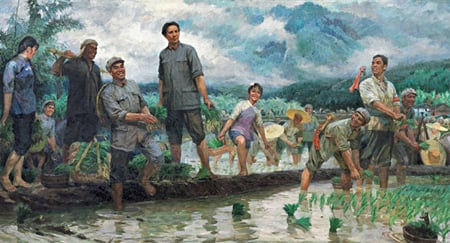
Read about the auction highlights fo China’s eight major auction houses in China.

Li Zhi

Starting this week, activities and events will be presented as part of the fall auction season in China. China Guardian will celebrate its 20th anniversary with a series of sales, featuring more than 5,000 artworks from around the world. Poly Auction is celebrating its 8th anniversary, conducting sales that focus on 20th-century classical paintings. Other leading Chinese auction houses, including Beijing Council International Auction, Rongbaozhai Auction, Xiling Yinshe Auction, Beijing Chengxuan Auctions, Huachen Auctions, and Hanhai Auction, will feature special sales across a variety of collecting categories—from Chinese classical paintings and calligraphy, Chinese ceramics and works of art, and Modern and Contemporary Chinese Art to fine furniture, ancient books and manuscripts, and jewelry—in which many items are expected to draw enthusiastic attention from the art market.
China Guardian Auctions Co., Ltd.
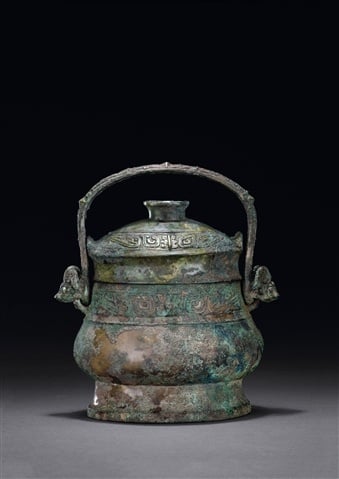
A bronze ritual wine vessel, Western Zhou (c.1099–771 B.C.), bronze, sold at China Guardian Auctions Co., Ltd., Beijing, China
A major highlight from China Guardian this season is an important archaic bronze ritual wine vessel, dating to the Western Zhou dynasty (c.11th –771 B.C.). The pear-shaped body is raised on a spreading foot encircled by a bowstring band and cast with two taotie (animal-shaped masks) on either side of the body. The cover is similarly decorated with a cast design in the shape of a kuilong dragon. Both the interior of the vessel and the cover are cast with a seven-character inscription. The object has been documented in various publications beginning in 1930. The shape, the ornaments, and the inscription of the object are most similar to those of the collection in the Shanghai Museum, the Princeton University Art Museum, and the Palace Museum in Beijing.
Another lot that is expected to take center stage is a large huali painting table with a solid board top and footstool, designed by the legendary Chinese furniture collector Wang Shixiang (1914–2009), and crafted by his student, the celebrated furniture maker, Tian Jiaqing. The huali painting table epitomizes the Ming dynasty ideal of classical Chinese furniture. The table was made of an unusually large single piece of huali wood, measuring nearly nine feet long. In his diary, Wang wrote extensively on how he acquired the extraordinary huali material, and on his deliberation on conceiving the design with Tian. Having seen the completion of the table, Wang drafted an inscription noting the significance of the piece, which is now carved on the lower rim of the table top.
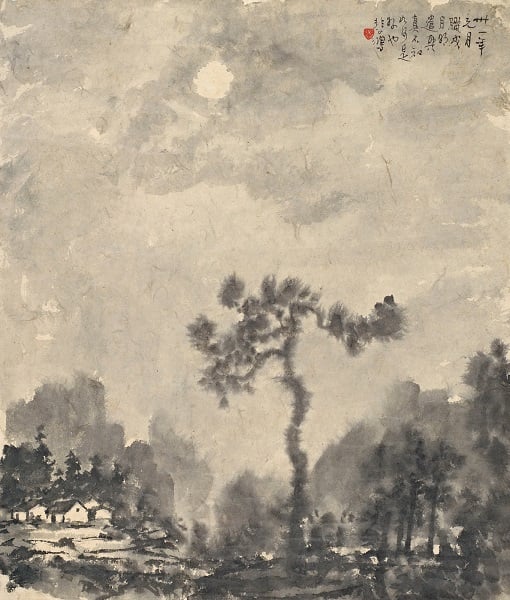
Xu Beihong, Moonlit Night in Lashio, 1942, ink on paper, sold at Beijing Chengxuan Auctions
Beijing Chengxuan Auctions Co., Ltd.
Beijing Chengxuan’s Chinese painting sales feature important Modern and Contemporary artworks. Among the works for sale is Moonlit Night in Lashioby Xu Beihong (Chinese, 1895–1953), one of the leading figures in the Chinese Socialist Realism art movement. Trained in Japan and France, Xu was adept in both Western painting and the Chinese ink tradition. He is most renowned for painting galloping horses, often seen as a reflection of the intrepid spirit of the Chinese people. Very few of his paintings in the traditional ink style exist, making Moonlit night in Lashio a rare piece to come to auction. Xu created the painting in 1942, on his way home to China via Lashio, Burma, during the Asia-Pacific and Sino-Japanese Wars. The misty landscapes and gloomy skies reveal the artist’s anxiety in the midst of social and political instability in China.
The sculptural work Miracle, by the acclaimed artist Xiang Jing (Chinese, b.1968), uses images of women to provoke discussion around gender issues in her native China. Ranging from miniature to large-scale female nudes, Xiang’s works engage the viewers in oft-controversial conversations. Miracle depicts a woman reclining on a sofa, gazing toward the distance with an expression of agony and confusion; an infant rests against her. Like Xiang’s other works in her series, Your Body and Virgin, the sculpture provokes discussion about the dilemma of motherhood and femininity. This piece is an important example of Xiang’s early work.
Xiling Yinshe Auction Co., Ltd.
This fall, Xiling Yinshe Auction Co., Ltd. presents significant works by early masters in Chinese classical painting and calligraphy sales. In the work After the Manuscript of Chunhua Pavilion, calligrapher Wang Duo (Chinese, 1592–1652) demonstrates his unorthodox aesthetics in cursive script with vigorous, dynamic, and unrestrained brushstrokes. Wang, active in the late Ming and early Qing dynasties, was a native of Mengjin, Henan. Emerging from poverty, he gained a jinshi degree in the imperial examination and served as a civil official of the grand secretariat (daxueshi) in the Ming and Qing courts. Wang’s calligraphy is best known for its forcefulness coupled with a graceful ease. His style is drastically different from the prevailing style of his contemporary Dong Qichang (Chinese, 1555–1636), whose writing is characterized by compactness and precision.
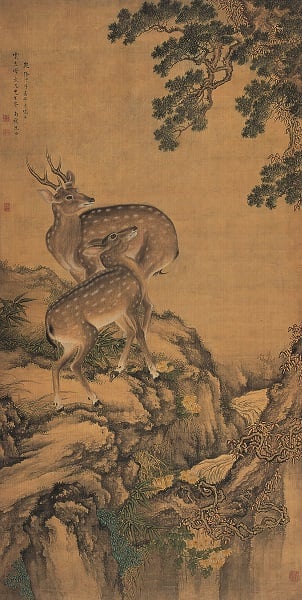
Shen Quan, Two deer, 1744, ink and color on silk, on hanging scroll, sold at Xiling Yinshe Auction Co., Ltd., Hangzhou, China
Two Deer by Shen Quan (Chinese, 1682–1762) exemplifies the refinement typified by the meticulous bird-and-flower tradition. Shen was a native of Huzhou in the Zhejiang Province. He was a folk artist, specializing in images of birds, flowers, and animals painted in a careful, delicate manner. In 1729, he was invited to Japan by a high-ranking official, and stayed there for three years. His paintings depicting delicate pines, bamboo, cranes, and peacocks, which often symbolized longevity, fortune, and dignity, were very popular among the Chinese and have drawn many followers in Japan. The deer in the painting, lu, is a homophone of “prosperity” or “official salary” in Chinese, which symbolically bestows the artist’s well-wishes upon the recipient of the painting.
Beijing Council International Auction Co., Ltd.
Beijing Council is featuring the sale Tranquility and Cultivation—Magnificent Imperial Cloisonné Enamels as part of its upcoming autumn auction season. The sale features examples of imperial cloisonné enamelware objects made during the Ming and Qing dynasties with various vessels, including censers, vases, and plates. Cloisonné is the technique of creating designs on metal vessels with colored-glass paste placed within enclosures made of copper or bronze wires, which have been bent or hammered into the desired pattern. The cloisonné is believed to have been introduced to China as early as the 13th century. The circular dish is an early example of the mature style of the Ming cloisonné. It is enameled with scrolling, stylized flowers and leaves, displayed on a deep turquoise ground. It bears a wanli reign mark, dated to the late 16th and early 17th centuries.
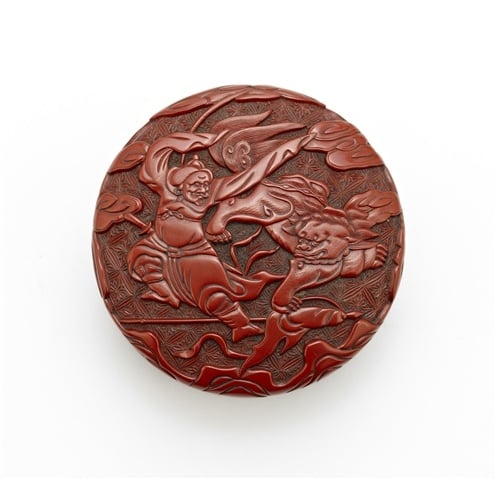
A rare tihong carved cinnabar lacquer box and cover, Ming dynasty (c.1368–1644), sold at Beijing Hanhai Auction Co., Ltd.
Lacquerware has long been cherished by Chinese collectors for its extravagant craftwork, elaborate design, and auspicious red color. Lacquer craftsmanship was well established by the Southern Song dynasty, and thrived during the Yuan and the Ming dynasties. The lacquer technique tihong, or “carving in red,” involves the application of thin lacquer paints onto the surface of an object with carvings applied before the paint dries. Paint may be applied in as many as 100 layers. The pictorial design on the box and cover, charged with vitality and sculptural energy, exemplifies the sophistication of Yuan workmanship. The scene of a man and lion is a typical motif, which flourished in the same period.
Poly International Auction Co., Ltd.

Chen Danqing, Going to Town, 1982, oil on canvas, sold at Poly International Auction Co., Ltd., Beijing, China
Chinese Classical Realism has always been the main strength of Poly sales. This fall, Poly will present important works by celebrated Realist artists, including Chen Yifei, Ai Xuan, Wang Yidong, Yang Feiyun, Li Guijun, Chen Yanning, Long Liyou, Liu Yi, Pang Maokun, and Guo Runwen.
Seen above, Chen Danqing’s Going to Town exemplifies the Classical Realist style, and was a commissioned work painted during the artist’s stay in the United States. The confusion and nostalgia vividly expressed on the face of the Tibetan man are indicative of the cultural conflicts that the artist himself experienced while living in a foreign country.
As part of Poly’s day sales, notable works include Leng Jun’s Dancer and Bamboo, Luo Zhongli’s Sailing to the Sea, and Jiang Guofang’s Sunrise in Chuxiu. In addition, 13 significant works introduced in the exhibition of The Stars Group, the first Chinese avant-garde group in post-Cultural-Revolution China, will be up for auction. Featured Contemporary artworks include Zeng Fanzhi’s Mask,Zhou Chunya’s Green Dog, Liu Xiaodong’s Smoking by the Water, and Zhang Xiaogang’s Sleeping Boy.
Beijing Huachen Auctions Co., Ltd.
This season, Huachen Auction presents Photo Album of the Anti-Japanese War in the Baiyangdian Region. This album is a valuable visual documentation of the Second Sino-Japanese War in the Jizhong area in the Hebei Province of China. Between 1940 and 1945, in response to the advocacy of “Photography and Salvation,” a group of photojournalists headed by Shi Shaohua (Chinese, 1918–1998) entered the war zone in the Baiyangding region to take pictures of the army and the people for propaganda purposes. The album chronologically documented the establishment of the Jizhong Revolutionary Base, the lives of the armed water guerrillas, Yanling, and the battles between the Jizhong army and the Japanese army. The photographs are inscribed and are in very good condition.

Tang Xiaohe and Cheng Li, Spring Shower in Jinggangshan, 1976, oil on canvas, sold at Beijing Huachen Auctions Co., Ltd.
Another important work is Spring Showing in Jingganshan by Cheng Li and Tang Xiaohe (Chinese). Painted in the Socialist Realism style, the monumental painting depicts Mao standing in a prominent position, surrounded by zealous soldiers and workers, in celebration of the virtues of communism and patriotism. The subject of Mao in Jingangshan, in large-scale paintings and smaller posters, was a widespread propagandistic theme during the Cultural Revolution. Unlike the images in which Mao is set against scenes of revolutionary uprising or as a unifier of the armed forces, Spring Shower represents the leader working with his people on farmland, demonstrating the artists’ innovative treatment of the historical subject.
Beijing Hanhai Auction Co., Ltd.
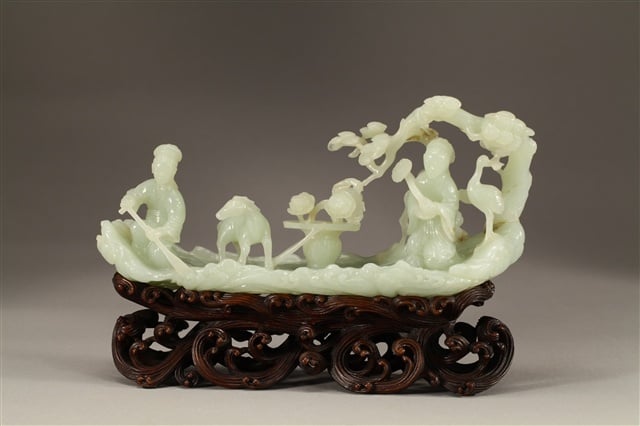
Finely carved white jade with Magu on a raft, Qianlongera of the Qing dynasty (c.1736–1795), sold at Beijing Hanhai Auction Co., Ltd.
Highlighted works from Hanghai Auction this season include the work A finely-carved white jade with Magu on a raft, which was likely used as a decorative object. The Daoist immortal, Magu, is featured on the raft holding a ruyi scepter as she stands beside a crane grasping a lingzhi fungus stem in its beak beneath the branches of a pine tree growing from the corner of the raft. In the center is a basket of flowers and a deer, who looks at the attendant paddling at the front. The base, a semi-translucent stone of pale greenish-white, is carved as the gnarled underside of the raft atop swirling waves. This lot was featured on the cover of the catalogue for the 2011 Christie’s New York sale Superb Jade Carvings from an Important European Collection.
Another significant work is a very fine Guan-type beast-handle vase from the Yongzheng era of the Qing dynasty (1723–1735). The vase bears a six-character seal mark, “da qing yong zheng nian zhi,” and is greatly inspired by the style of the Southern Song dynasty (1127–1279). The shape of the vessel imitates the archaic bronze vessel zun, typified by the round belly and the handles in the form of an imaginary beast. The vase exemplifies the innovations in porcelain making that took place during the Yongzheng reign. The Yongzheng emperor’s fascination with antiquity, and his demand for high-quality works, resulted in the refinement of craftsmanship during the period. The signature works of Yongzheng porcelain, however, are those whose deceptive simplicity made the greatest demands on the potters’ aesthetic conception and technical ability.
Rongbaozhai (Shanghai) Auction Co., Ltd.
Rongbaozhai Auction is presenting works from 20th-century Chinese ink and color masters, including Li Keran (Chinese, 1907–1989) and Huang Zhou (Chinese, 1925–1997). Li Keran’s Plum Blossom in the Spring depicts a herder atop a water buffalo, riding joyfully under the blossoming plum trees. In 1940, while living with a farming family near Chongqing, Li occupied a room next to the buffalo stables. His close proximity to the buffalo made him reflect on the animal’s important contribution to farming through its labor in the field, as well as through its skin, meat, bones, and horns. Not long after that, Li began to paint herders and water buffaloes, endowing this traditional subject matter with new significance through his use of the innovative, splashed-ink technique. He named his painting studio “Hut where I learn from the buffalo,” inspired by Lu Xun‘s well-known line, “willingly I become a bull for the sake of the children,” and Guo Moruo‘s essay, In Praise of Water Buffalo, in which Guo suggests that the water buffalo should be regarded as a national emblem.
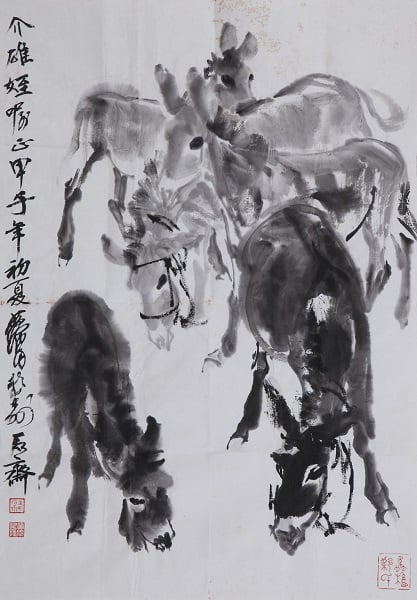
Huang Zhou, Five Donkeys, ink on paper, on hanging scroll, sold at Bonhams Hong Kong
Five Donkeys is a painting dedicated to Huang Zhou ’s friend Chen Jiexiong, son of the celebrated patriarch of Modern Chinese photography, Chen Fuli (Chinese, b.1916). Huang Zhou’s portray of donkeys, together with Li Keran’s water buffaloes, Xu Beihong’s horses, and Qi Baishi’s shrimps, are hailed as the “Four Marvels of Chinese Ink Painting.” During the Cultural Revolution, Huang was sent to the countryside, where he spent three years herding and farming donkeys. The experience gave him ample time to closely observe the animals and form a unique representation of them. In the composition, Huang applies dry and moist inks to form the structure of the donkey, resulting in an array of light and heavy, thin and robust strokes.